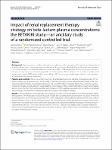Item Infomation
Full metadata record
| DC Field | Value | Language |
|---|---|---|
| dc.contributor.author | Damien, Roux | - |
| dc.contributor.author | Nicolas, Benichou | - |
| dc.contributor.author | David, Hajage | - |
| dc.date.accessioned | 2023-03-21T02:40:10Z | - |
| dc.date.available | 2023-03-21T02:40:10Z | - |
| dc.date.issued | 2023 | - |
| dc.identifier.uri | https://link.springer.com/article/10.1186/s13613-023-01105-0 | - |
| dc.identifier.uri | https://dlib.phenikaa-uni.edu.vn/handle/PNK/7010 | - |
| dc.description | CC BY | vi |
| dc.description.abstract | Sepsis prognosis correlates with antibiotic adequacy at the early phase. This adequacy is dependent on antibacterial spectrum, bacterial resistance profile and antibiotic dosage. Optimal efficacy of beta-lactams mandates concentrations above the minimal inhibitory concentration (MIC) of the targeted bacteria for the longest time possible over the day. Septic acute kidney injury (AKI) is the most common AKI syndrome in ICU and often mandates renal replacement therapy (RRT) initiation. Both severe AKI and RRT may increase outside target antibiotic concentrations and ultimately alter patient’s prognosis. | vi |
| dc.language.iso | en | vi |
| dc.publisher | Springer | vi |
| dc.subject | minimal inhibitory concentration | vi |
| dc.subject | acute kidney injury | vi |
| dc.title | Impact of renal replacement therapy strategy on beta-lactam plasma concentrations: the BETAKIKI study—an ancillary study of a randomized controlled trial | vi |
| dc.type | Book | vi |
| Appears in Collections | ||
| OER- Y học- Điều dưỡng | ||
Files in This Item:

